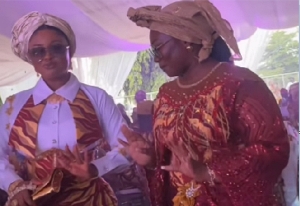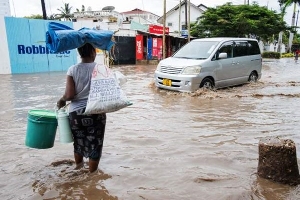Opinions of Monday, 25 October 2010
Columnist: Okoampa-Ahoofe, Kwame
Cocoa: Ghana’s Prosperity Began in the Eastern Region
By Kwame Okoampa-Ahoofe, Jr., Ph.D.
This article partly rejoins another one that was captioned “Oil – The Curse Begins in Takoradi,” which was originally published in the Daily Guide (See also Modernghana.com 10/15/10). The article was written by Mr. Kwesi Biney, the well-known Ghanaian journalist and, if memory serves this writer accurately, a former District Chief Executive (DCE) under the Kufuor government of the New Patriotic Party (NPP).
Well, if he is the same person (and there appears to be no reason to believe that he is not), then about one-and-half decades, or so, ago, I had the privilege of meeting Mr. Biney in the company of another quite prominent African journalist from Uganda by the name of Ms. Lydia Wamala. The two, I believe, were part of a contingent of African journalists then visiting the United States, perhaps, as has been the tradition in the past, at the invitation of the U.S. Department of State.
My younger sister had met Mr. Biney and Ms. Wamala and decided to have them briefly over at our now-late parents’ Washington Heights apartment. I was then living in Queens Borough and came over that evening to meet these evidently fine and quite remarkable media operatives. Naturally, my sister, Yaa Agyeman (Lucky), had called me up to meet with Mr. Biney and Ms. Wamala because I also freelanced as a general-assignment reporter for the New York Amsterdam News. I would later be named book-review editor, a largely unpaid position, albeit a prestigious one at a globally-renowned African-American weekly.
I don’t quite remember much of what transpired by way of conversation, although I faintly recall it being a rather delightful evening.
Anyway, what provoked this measured rejoinder, exactly one week after reading the same, regards Mr. Biney’s rather exaggerated claims to the effect that the rest of Ghana has largely “survived on the shoulders of the Western Region, which [allegedly] produces 100% of [Ghana’s] Bauxite, 100% of Manganese, 60% of Cocoa, 100% of Rubber, 15% of Oil-Palm, 60% of Gold and 25% of Timber, the major exports of this country.”
We must quickly point out, here, the fact that Mr. Biney’s article is more about the equitable sharing of Ghana new-found oil revenue, most of which resource is to be extracted from the coastal waters bordering the Western Region. I must also promptly observe that I have great respect for the latter region and its people, being that both an elder sibling and my father attended GSTS when it was prestigiously known as Government Secondary Technical School, rather than its deftly demoted status of Ghana Secondary Technical School and the oldest of its kind in our country, having been founded in 1909. Actually, when the old man attended GSTS between 1948 and 1952, it was a highly selective technical teachers’ training college. I would barely miss attending GSTS myself in 1975. I am, however, glad, in retrospect, that my admission application, which had been mailed in rather late by Akropong-SALEM’s Master Quansah, had been promptly and roundly rejected. I would shortly discover, to my utter delight, of course, that I was, indeed, a thoroughgoing liberal arts material. Back in 1975, though, my “Pass-No-Way” status felt almost as if the very bottom of my plate of destiny had fallen off a precipice.
Anyway, anybody who has studied the history of the cocoa industry perfectly knows that by 1910, when the erstwhile Gold Coast became recognized as the world’s leading – or number one – producer of the chocolate-making seedling, as I routinely vaunt to my students, Mr. Biney’s Western Region was nowhere to be found on the map of the major cocoa-growing areas of our country. If any production of this staple export commodity existed in the Western Region at all, this was largely marginal, as authentic records would show. And the naked truth of the latter observation is attested by the fact of WACRI, the West African Cocoa Research Institute, having been established at Akyem-Tafo, in the heart of the Eastern Region, of course.
And so if today, as the author of “Oil – The Curse Begins in Takoradi” angrily claims, 60% of our country’s cocoa is reported as being produced in the Western Region, this is a rather recent development. Still, what is fascinating, if also because of its unconscionable cynicism, is the fact that opponents of the most famous citizen from the Western Region, Mr. Kwame Nkrumah, have been mordantly reviled for demanding a federal form of government, precisely for the same reasons that Mr. Biney religiously believes that the Western Region ought to be allotted a greater share of our new-found oil revenue.
In other words, Mr. Biney seems to conveniently overlook the environmental hazard wreaked by the cocoa industry in the Eastern and Asante regions over time, and at the expense of Ghana’s local food industry, while alarmingly highlighting the environmental pollution that is bound to be unleashed by oil extraction in the Western Region’s littoral. But whether the relative underdevelopment of the Western Region, as the crusading critic alleges, ought to be blamed on our present “technocrats,” rather than President Nkrumah and his Convention People’s Party (CPP) operatives, is one that may well require a national policy debate.
Interestingly, the critic decided to leave out the production of Diamond, a mineral resource that is of far more economic significance than Manganese, obviously because this “Akyem-Product” is not found in commercial quantities in the Western Region. Even so, such omission is nothing short of the downright insulting, especially since the main thrust of Mr. Biney’s argument is that his region of birth and/or descent is Ghana’s bread-basket. Does this therefore mean that “Akwatia-Diamond,” which fetches far more revenue than Manganese and Bauxite combined, is absolutely of no economic significance to Ghana’s overall development?
And unless he zanily believes that Obuasi is located in the Axim district, Mr. Biney has no tangible excuse for rather mischievously claiming 60% of our country’s gold deposits to be mined outside Great Asante. Then again, as surprising as it might seem, still, it is not impossible for the critic not to have heard of such towns and locales as Konongo, Nyinahin and Atiwa-Atweredu, thus his rather sophomoric claim of 100% of Ghana’s bauxite being supposedly produced in the Western Region.
On the subject of Rubber production, had he published his article some sixty years ago, I personally would have taken Mr. Biney to Akyem-Asiakwa and conducted him around Nana Aboagye’s multi-crop plantation. Still, with his kind of boastfulness, one would have expected Mr. Biney to have made a perfect claim – or accorded 100% credit – to his region for the production of Oil-Palm and Timber, instead of a piddling 15% and 25%, respectively. In other words, there are more meaningful ways of pleading one’s perceived special cause than presumptuously and falsely attempting to belittle the worth of others on the basis of badly cooked data.
*Kwame Okoampa-Ahoofe, Jr., Ph.D., is Associate Professor of English, Journalism and Creative Writing at Nassau Community College of the State University of New York, Garden City. He is a Governing Board Member of the Accra-based Danquah Institute (DI) and the author of “Atumpan” (iUniverse.com, 2004). E-mail: okoampaahoofe@optimum.net.
###












